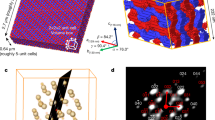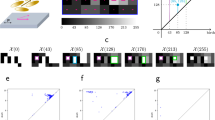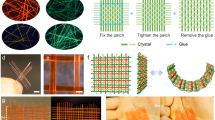Abstract
Microstructure evolution in complex nonlinear systems is of great interest from both scientific and engineering viewpoints. Here, we consider an important case of such an evolution, a coherent decomposition of a homogeneous parent phase involving the symmetry-lifting crystal lattice rearrangement of the product phase. It is shown that under certain conditions the transformation develops as a pseudospinodal decomposition, which is defined as a transformation with continuous changes of the compositions of both decomposed phases towards their equilibrium values. The pseudospinodal decomposition starts by the formation of a nanodomain precursor state with a so-called tweed structure. The three-dimensional modelling demonstrates that this tweed structure has an underlying chessboard feature, and this arrangement is a template for the further microstructure development that eventually produces a coherent two-phase chessboard nanowire pattern. The proposed theory and modelling describe the mechanism of the pseudospinodal decomposition and predict all observed three-dimensional features of the chessboard structure.
This is a preview of subscription content, access via your institution
Access options
Subscribe to this journal
Receive 12 print issues and online access
$259.00 per year
only $21.58 per issue
Buy this article
- Purchase on Springer Link
- Instant access to full article PDF
Prices may be subject to local taxes which are calculated during checkout




Similar content being viewed by others
References
Leroux, C., Loiseau, A., Broddin, G. & Van Tendeloo, G. Electron microscopy study of the coherent two-phase mixtures L10+L12 in Co–Pt alloys. Phil. Mag. B 64, 57–82 (1991).
Udoh, K. I. et al. Structural aspects of AuCu I or AuCu II and a cuboidal block configuration of fcc disordered phase in AuCu-Pt and AuCu-Ag pseudobinary alloys. Mater. Sci. Eng. A 203, 154–164 (1995).
Bendersky, L. A. & Boettinger, W. J. Phase transformations in the (Ti,Nb)3Al section of the Ti-Al-Nb system II. experimental TEM study of microstructures. Acta Metall. Mater. 42, 2337–2352 (1994).
Suzuki, A. & Takeyama, M. Formation and morphology of Kurnakov type D022 compound in disordered face-centered cubic γ-(Ni,Fe) matrix alloys. J. Mater. Res. 21, 21–26 (2006).
Van Tendeloo, G. & Amelincks, S. Long-period antiphase boundary structures in the ordered alloy Au4Zn II. growth mechanism of the LPAPB structure. Phys. Status Solidi A 50, 53–66 (1978).
Yeo, S. et al. Solid state self-assembly of nanocheckerboards. Appl. Phys. Lett. 89, 233120 (2006).
Zhang, C. L. et al. Coercivity and nanostructure in magnetic spinel Mg(Mn,Fe)2O4 . Appl. Phys. Lett. 90, 133123 (2007).
Zhang, C. L. et al. Magnetic nanocheckerboards with tunable sizes in the Mn-doped CoFe2O4 spinel. Appl. Phys. Lett. 91, 233110 (2007).
Guiton, B. S. & Davies, P. K. Nano-chessboard superlattices formed by spontaneous phase separation in oxides. Nature Mater. 6, 586–591 (2007).
Park, S. et al. Highly aligned epitaxial nanorods with a checkerboard pattern in oxide films. Nano Lett. 8, 720–724 (2008).
Le Bouar, Y., Loiseau, A. & Khachaturyan, A. G. Origin of chessboard-like structures in decomposing alloys: Theoretical model and computer simulation. Acta Mater. 46, 2777–2788 (1998).
Khachaturyan, A. G., Lindsey, T. F. & Morris, J. W. Theoretical investigation of the precipitation of δ′ in Al-Li. Metall. Mat. Trans. A. 19, 249–258 (1988).
Soffa, W. A. & Laughlin, D. E. Decomposition and ordering processes involving thermodynamically first-order order to disorder transformations. Acta Metall. 37, 3019–3028 (1989).
Wang, Y. Z., Wang, H. Y., Chen, L. Q. & Khachaturyan, A. G. Shape evolution of a coherent tetragonal precipitate in partially stabilized cubic ZrO2: A computer simulation. J. Am. Ceram. Soc. 76, 3029–3033 (1993).
Wang, Y. Z., Wang, H. Y., Chen, L. Q. & Khachaturyan, A. G. Microstructural development of coherent tetragonal precipitates in Magnesium-partially-stabilized Zirconia: A computer simulation. J. Am. Ceram. Soc. 78, 657–661 (1995).
Wang, Y. Z. & Khachaturyan, A. G. Three-dimensional field model and computer modeling of martensitic transformations. Acta Mater. 45, 759–773 (1997).
Ni, Y., Jin, Y. M. & Khachaturyan, A. G. The transformation sequences in the cubic→tetragonal decomposition. Acta Mater. 55, 4903–4914 (2007).
Artemev, A., Jin, Y. M. & Khachaturyan, A. G. Three-dimensional phase field model of proper martensitic transformation. Acta Mater. 49, 1165–1177 (2001).
Tanner, L. E. Diffraction contrast from elastic shear strains due to coherent phases. Phil. Mag. 14, 111–130 (1966).
Laughlin, D. E., Sinclair, R. & Tanner, L. Comments on the early stages of the transformation in dilute alloys of titanium in Nickel. Scr. Metall. 14, 373–376 (1980).
Robertson, I. M. & Wayman, C. M. Tweed microstructures I. characterization in β-NiAl. Phil. Mag. A 48, 421–442 (1983).
Acknowledgements
The authors gratefully acknowledge the support from NSF DMR under the grant NSF DMR-0704045. The simulations were performed on the DataStar in the San Diego Supercomputer Centre.
Author information
Authors and Affiliations
Contributions
Y.N. carried out most of the analysis and simulation in the research. A.G.K. planned the research and supervized it. The article was written by A.G.K. and Y.N.
Corresponding author
Supplementary information
Supplementary Information
Supplementary Information (PDF 600 kb)
Rights and permissions
About this article
Cite this article
Ni, Y., Khachaturyan, A. From chessboard tweed to chessboard nanowire structure during pseudospinodal decomposition. Nature Mater 8, 410–414 (2009). https://doi.org/10.1038/nmat2431
Received:
Accepted:
Published:
Issue Date:
DOI: https://doi.org/10.1038/nmat2431
This article is cited by
-
Bicontinuous oxide heteroepitaxy with enhanced photoconductivity
Nature Communications (2023)
-
Extremely Rapid Age Hardening in Ti-5Al-2Fe-3Mo Solution Treated at High α + β Temperature Region
Metallurgical and Materials Transactions A (2021)
-
Mechanism of collective interstitial ordering in Fe–C alloys
Nature Materials (2020)
-
Characterization of the Interfacial Structure of Coarse α Precipitates in a Metastable β-Ti Alloy Ti-5Al-5Mo-5V-3Cr
JOM (2019)
-
New high-strength Ti–Al–V–Mo alloy: from high-throughput composition design to mechanical properties
International Journal of Minerals, Metallurgy and Materials (2019)



